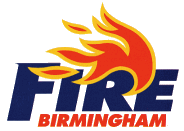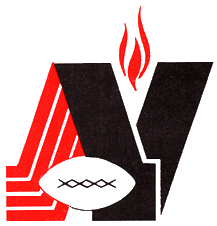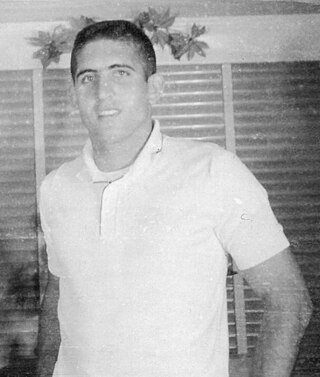
The World Football League (WFL) was an American football league that played one full season in 1974 and most of its second in 1975. Although the league's proclaimed ambition was to bring American football onto a worldwide stage, the farthest the WFL reached was placing a team – the Hawaiians – in Honolulu, Hawaii. The league folded midway through its second season, in 1975. A new minor football league began play as the World Football League in 2008 after acquiring the rights to its trademarks and intellectual property; it folded in 2011.

The Memphis Southmen, also known as the Memphis Grizzlies, were an American football team based in Memphis, Tennessee. They played in the World Football League (WFL), which operated in 1974 and 1975. They played their home games at Liberty Bowl Memorial Stadium.
The Charlotte Hornets were an American football team in the short-lived professional World Football League. Despite their brief existence, the Hornets were North Carolina's first attempt at a major league football team, predating the Carolina Panthers by two decades. They were relocated to Charlotte, North Carolina, from New York City in the middle of the 1974 season.
The Jacksonville Express were a professional American football team based in Jacksonville, Florida which competed in the World Football League (WFL) in 1975. They were preceded in 1974 by the WFL's Jacksonville Sharks, though the two teams had separate ownership and identities. The Express folded when the league ceased operations during the 1975 season.

Legion Field is an outdoor stadium in the southeastern United States in Birmingham, Alabama, primarily designed to be used as a venue for American football, but occasionally used for other large outdoor events. Opened in 1927, it is named in honor of the American Legion, a U.S. organization of military veterans.
The Shreveport Steamer were a professional American football team in the World Football League. The franchise began the 1974 season in Houston, Texas, as the Houston Texans, playing their home games at the Houston Astrodome. Toward the end of the season, the team relocated to Shreveport, Louisiana, and became the Shreveport Steamer. They played at the 30,000-seat State Fair Stadium, now named Independence Stadium. Larry King, of future CNN fame, was one of their broadcasters.

The Birmingham Vulcans were a professional American football team located in Birmingham, Alabama. They were members of the five-team Eastern Division of the World Football League (WFL). The Vulcans, founded in March 1975, played in the upstart league's second and final season in 1975. The team was owned by a group of Birmingham businessmen with Ferd Weil as team president.

Kenneth Michael Stabler was an American professional football quarterback who played in the National Football League (NFL) for 17 seasons, primarily with the Oakland Raiders. Nicknamed "Snake", he played college football at Alabama and was selected by the Raiders in the second round of the 1968 NFL Draft. During his 10 seasons in Oakland, Stabler received four Pro Bowl selections and was named Most Valuable Player in 1974. Stabler also helped the Raiders win their first Super Bowl title in the Super Bowl XI. He was posthumously inducted to the Pro Football Hall of Fame in 2016.

The Birmingham Fire were a professional American football team based in Birmingham, Alabama. They were a member of the North American West division of the World League of American Football (WLAF) and played their home games at Legion Field. The club was a charter member of the WLAF, and was under the ownership of Gavin Maloof. Led by head coach Chan Gailey, the Fire saw moderate success as they compiled an overall record of twelve wins, nine losses and one tie (12–9–1) and made the playoffs in both seasons they competed. The franchise folded in September 1992 when the NFL placed the league on an indefinite hiatus.

The Alabama Vulcans were a professional football team which were a part of the American Football Association in 1979. Though the Vulcans used a different color scheme than its predecessors did in the World Football League, the team's name was borrowed from the WFL's Birmingham Vulcans, and its logo was an amalgamation of those of the Vulcans and the Birmingham Americans to draw on the popularity of the previous league's teams. They were owned by Harry Lander, who also served as the team's head coach and the founder of the league. Their home stadium was Legion Field in Birmingham, Alabama. During the one season of the team's existence, it had a record of 13–6, with two five-game winning streaks. The team made the playoffs, but lost in the first round.
Charles Edward Harraway, Jr. is an American former professional football player who was a running back for eight seasons with the Cleveland Browns and Washington Redskins of the National Football League (NFL). He also played one season in the World Football League, with the champion Birmingham Americans in 1974. He played college football for the San Jose State Spartans.

George Ignacio Mira is a Cuban-American former football quarterback who played in eight National Football League (NFL) seasons for four teams. He then played five seasons in the Canadian Football League (CFL) and the World Football League (WFL).
Johnny Musso is an American former gridiron football player, who played professionally a running back for three seasons with the BC Lions of the Canadian Football League (CFL) and in the National Football League (NFL) with the Chicago Bears. Musso played college football at the University of Alabama, where was a consensus selection on the 1971 College Football All-America Team. He was inducted into the College Football Hall of Fame in 2000.
Dennis Frank Homan is a former professional American football wide receiver in the National Football League (NFL) for five seasons for the Dallas Cowboys (1968–1970) and the Kansas City Chiefs (1971–1972). He later played for the Birmingham Americans (1974) and Birmingham Vulcans (1975) of the World Football League (WFL).
Matthew Reed is an American former gridiron football player. He played professionally as a quarterback in the World Football League (WFL) and the Canadian Football League (CFL).
The World Bowl, also known as World Bowl 1, was the only American football championship game of the short-lived World Football League. The Birmingham Americans defeated the Florida Blazers 22–21 on Thursday, December 5, 1974 at Legion Field in Birmingham, Alabama. George Mira, quarterback for Birmingham was named the game's Most Valuable Player (MVP). It was televised on TVS Television Network.
The 1991 Birmingham Fire season was the first for the franchise in the inaugural season for the World League of American Football (WLAF). The team was led by head coach Chan Gailey, and played their home games at Legion Field in Birmingham, Alabama. They finished the season with a record of five wins and six losses (5–6), as the North America West division champions and with a loss against the Barcelona Dragons in the WLAF semifinals.
The 1974 World Football League season was the first season of the World Football League.
The 1975 World Football League season was the second and last season of the World Football League. The 1975 season was to be an 18-game season over a twenty-week schedule.
Halver "Buddy" Brown, Jr. is a former American football player. He played offensive guard for the University of Alabama Crimson Tide from 1971 through 1973 and was a member of the 1973 national championship team and a consensus selection to the 1973 College Football All-America Team. After his collegiate career, Brown played professionally for the Birmingham Americans in 1974 and the Winnipeg Blue Bombers from 1975 through 1979.











